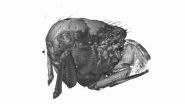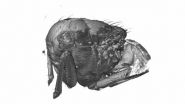(Press-News.org) Knowing what another person wants is not a trivial issue, particularly when the other's desires are different from our own. The ability to disengage from our own desire to cater to someone else's wishes is thought to be a unique feature of human cognition.
New research challenges this assumption. Despite wanting something different to eat, male Eurasian jays can disengage from their own current desire in order to feed the female what she wants even when her desires are different to his. The study, which was funded by the BBSRC, is published today in the Royal Society journal Biology Letters.
"We found that males could respond to the female's desire even when their own desire was conflicting. That said, the males were also partially biased by what they wanted – a bias similar to one commonly found in human children and adults," said Dr Ljerka Ostojić, who led the University of Cambridge study.
For the study, nine male-female pairs of Eurasian jays (a member of the Corvid family) from two colonies were tested during the breeding season – the only time when jays share food. To manipulate what food the males and the females desired, the researchers used a phenomenon termed 'specific satiety' – after eating a particular food item to satiety, jays prefer to eat a novel food item that they are not currently sated on.
Once a day the females and males were placed in adjacent compartments with a mesh window in between. The male was then pre-fed either wax moth larvae or mealworm beetle larvae – both favourite treats for jays - until he did not want more. At the same time, the female's desire was manipulated by giving her the same food as the male (meaning that their desires were matching), a different food from the male (meaning that their desires were conflicting), or her usual diet (meaning that the female's desire was neutral towards the two types of larvae).
During the pre-feeding, the male had visual access to the female and saw her eat. At the end of pre-feeding, all food was removed. The males were then given 20 choices between a single wax moth larva and a mealworm beetle larva which they could either eat, cache (hide for later) or give to the female.
Not surprisingly, when the male and female birds' preferences were the same, the male fed the female the food desired by both. However, when the female's desire differed from the male's, then he took his partner's wishes into account, often feeding her the food that she desired. This ability to ascribe to another individual an internal life like one's own and at the same time understand that the other's internal, psychological states might differ from one's own is called state-attribution.
Professor Nicky Clayton, whose Comparative Cognition lab at Cambridge University's Department of Psychology conducted the study, said: "As humans, we 'put ourselves into someone else's shoes' in order to respond to what the other person wants. Although we are biased by our own current desires, we can inhibit these to put the wants and desires of another before our own. The current findings show that the jays can also do this. So what this research suggests is that a common mechanism might underlie 'desire-state attribution' in humans and jays."
INFORMATION: END
Male Eurasian jays know that their female partners' desires can differ from their own
2014-03-26
ELSE PRESS RELEASES FROM THIS DATE:
Study is first to provide direct evidence that response of unborn children to glucose is associated with mother's insulin sensitivity
2014-03-26
A study published in Diabetologia (the journal of the European Association for the Study of Diabetes) is the first to provide direct evidence that fetal brain response to a dose of sugar given orally to its mother is associated with the mother's insulin sensitivity. This may indicate that the risk of subsequent obesity and diabetes may be pre-programmed in the womb. The study is by Dr Hubert Preissl and Dr Andreas Fritsche, University of Tübingen, Germany and German Center for Diabetes Research (DZD), Neuherberg, Germany, and colleagues.
Diabetes or obesity in the mother ...
Clean cooking fuel and improved kitchen ventilation linked to less lung disease
2014-03-25
Improving cooking fuels and kitchen ventilation is associated with better lung function and reduced chronic obstructive pulmonary disease (COPD), according to research published in this week's PLOS Medicine. The study, led by Pixin Ran from the Guanzhou Medical University, China, followed 996 villagers from southern China for 9 years to examine the effects of cleaner fuels and better kitchen ventilation on lung function and disease.
An estimated 3 billion people worldwide heat their homes and cook by burning biomass such as wood or animal dung. The resulting indoor air ...
X-rays film inside live flying insects -- in 3D
2014-03-25
VIDEO:
This video shows the insect thorax reconstructed from
tomograms and highlights the external movements of the thorax
and the location of the indirect power and steering muscles.
Click here for more information.
Scientists have used a particle accelerator to obtain high-speed 3D X-ray visualizations of the flight muscles of flies. The team from Oxford University, Imperial College, and the Paul Scherrer Institute (PSI) developed a groundbreaking new CT scanning technique ...
A way to end recurrent urinary tract infections? Study with mice gives hope
2014-03-25
(SALT LAKE CITY)—Millions of people worldwide – mostly women – suffer from recurrent urinary tract infections (UTIs) that seriously degrade their health and quality of life. Antibiotics treat individual infections, but preventing recurrent ones largely has been unattainable because of the way bacteria lodge in the inner layers of the bladder and quietly hide from drugs that can kill them.
In new studies with mice, however, researchers led by University of Utah microbiologists have shown that when chitosan, an FDA-approved compound for pharmaceutical, agricultural and ...
EEG study shows how brain infers structure, rules when learning
2014-03-25
PROVIDENCE, R.I. [Brown University] — In life, many tasks have a context that dictates the right actions, so when people learn to do something new, they'll often infer cues of context and rules. In a new study, Brown University brain scientists took advantage of that tendency to track the emergence of such rule structures in the frontal cortex — even when such structure was not necessary or even helpful to learn — and to predict from EEG readings how people would apply them to learn new tasks speedily.
Context and rule structures are everywhere. They allow an iPhone user ...
In-fly movie: 3D video from inside flying insects
2014-03-25
VIDEO:
This is a 3D movie of a blowfly's flight muscles moving created by Oxford University and Imperial scientists using a new X-ray scanning technique.
Click here for more information.
The flight muscles moving inside flies have been filmed for the first time using a new 3D X-ray scanning technique.
3D movies of the muscles were created by a team from Oxford University, Imperial College London, and the Paul Scherrer Institute (PSI), using the PSI's Swiss Light Source, ...
Strictly limiting hours surgical residents can work has not improved patient safety
2014-03-25
TORONTO, March 25, 2014--Strictly limiting the number of hours surgical residents can work has not improved patient outcomes but may have increased complications for some patients and led to higher failure rates on certification exams, a research paper concludes.
Traditionally, doctors in the residency phase of their training spent very long hours in a hospital –often around-the-clock--so they could see a wide variety and high volume of patients. In the last 10 years, health authorities started limiting those hours in the hopes of improving patient safety and the education ...
Unravelling nerve-cell death in rare children's disease
2014-03-25
LA JOLLA, Calif., March 25, 2014 — A team of scientists, led by Stuart Lipton, M.D., Ph.D., professor and director of the Neuroscience and Aging Research Center at Sanford-Burnham Medical Research Institute (Sanford-Burnham), recently discovered why cerebellar granule cell neurons in patients suffering from ataxia-telangiectasia (A-T) were unable to repair DNA damage and thus died.
A-T is a hereditary condition that begins early in childhood, and causes a gradual loss of certain nerve cells in the cerebellum of the brain. A-T occurs in about 1 in 40,000 births, with symptoms ...
Brain differences in college-aged occasional drug users
2014-03-25
Researchers at the University of California, San Diego School of Medicine have discovered impaired neuronal activity in the parts of the brain associated with anticipatory functioning among occasional 18- to 24-year-old users of stimulant drugs, such as cocaine, amphetamines and prescription drugs such as Adderall.
The brain differences, detected using functional magnetic resonance imaging (fMRI), are believed to represent an internal hard wiring that may make some people more prone to drug addiction later in life.
Among the study's main implications is the possibility ...
Penn study: Distance from designated VA liver transplant center linked with greater risk of death
2014-03-25
(PHILADELPHIA) – Veterans with liver disease who live more than 100 miles from a Veterans Administration hospital that offers liver transplants are only half as likely to be placed on the liver transplant waitlist to receive a new organ compared to veterans who live closer to transplant centers, according to a new study from the Perelman School of Medicine of the University of Pennsylvania. The findings, which are published in the March 26 issue of JAMA, also reveal that the further liver disease patients live from these five transplant centers, the more likely they are ...



